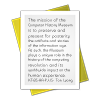Description
Abarbanel describes his work in numerical analysis, his use of early computers, and his work with a variety of colleagues in applied mathematics. Abarbanel was born and did his early schooling in Tel Aviv, Israel, and in high school developed an interest in mathematics. After serving in the Israeli army, Abarbanel entered MIT in 1950 as an as an engineering major and took courses with Adolf Hurwitz, Francis Begnaud Hildebrand, and Philip Franklin. He found himself increasing drawn to applied mathematics, however, and by the time he began work on his PhD at MIT he had switched from aeronautics to applied mathematics under the tutelage of Norman Levinson. Abarbanel recalls the frustration of dropping the punched cards for his program for the IBM 1604 that MIT was using in 1958 when he was working on his dissertation, but also notes that this work convinced him of the importance of computers. Abarbanel also relates a humorous story about Norbert Wiener, his famed linguistic aptitude, and his lesser-known interest in chess. Three years after receiving his PhD, Abarbanel returned to Israel, where he spent the rest of his career at Tel Aviv University. He used the WEIZAC computer at the Weizmann Institute, and in the late 1960s worked on a CDC machine and an early transistorized Philco computer owned by the Israeli army. Although Arbarbanel’s early work was more computational, his later work reflects his mid-career realization of the importance of theory in achieving practical results. He thoroughly enjoyed the time at NASA’s now defunct Institute of Computer Applications to Science and Engineering (ICASE), which he believes served an important role by bringing together outstanding scientists and mathematicians and allowing them an opportunity to become better acquainted and to collaborate more extensively. Besides his extensive collaboration with David Gottlieb, Abarbanel worked with a variety of colleagues during his career, including engineers Earll Murman and Ajay Kumar. He discusses well- and ill-posed equations, and distinguishes ill posedness and instability from chaos. Abarbanel, who has taught courses ranging from introductory math lectures to advanced seminars, has come to believe that teaching contributes significantly to research because students pose questions that the researcher would not ask himself. He believes that his training in engineering and aerodynamics gave him an advantage in doing applied mathematics thinks that today’s students in numerical analysis can benefit from exposure to the sciences and should receive training in a broad range of mathematical tools. Abarbanel thinks that his work with David Gottlieb demonstrating that linearized Navier-Stokes equations can be symmetrized and highlighting problems of boundary conditions for infinite fields in electromagnetics as among his most significant contributions.
Date
2003-07-29
Contributor
|
Abarbanel, Saul, Interviewee
|
|
Davis, Philip, Interviewer
|
Publisher
SIAM and U.S. Department of Energy
Place of Publication
Providence, Rhode Island, United States
Extent
23 p.
Format
PDF
Copyright Holder
Computer History Museum
Category
Transcription
Subject
Massachusetts Institute of Technology (MIT); Applied mathematics; IBM 1604 (Computer); Wiener, Norbert, 1894--1964; Tel Aviv University; WEIZAC (Computer); Institute of Computer Applications to Science and Engineering (ICASE)
Collection Title
Society for Industrial and Applied Mathematics (SIAM) oral history collection
Credit
Gift of SIAM and the US Department of Energy


